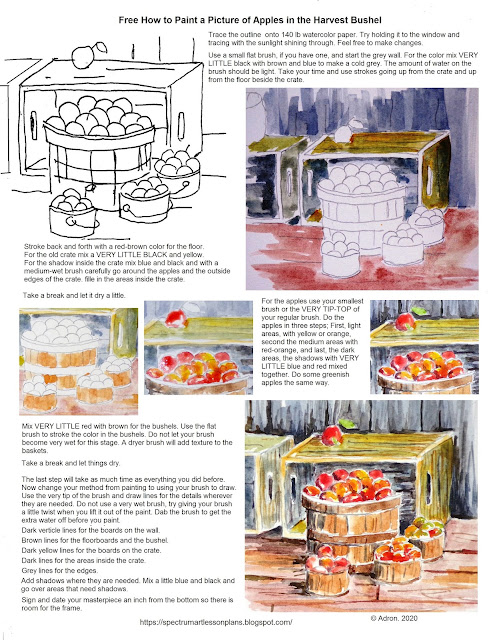I am delighted to share my how-to-paint A picture of the traveler's backpack.
👇👇👇SCROLL DOWN TO ACCESS THE FREE PDF.
You may print the images below.
 |
| How to Paint a Picture of the Traveler's Backpack Worksheet and Art Lesson |
Below is a supplemental page with the outline to trace on a large scale.
 |
| How to Paint a Picture of the Traveler's Backpack Pattern |
It takes me days to create a worksheet like this, but I do it because I believe when God gives you a gift, it is so you can be a gift. These worksheets are helpful for you.
If you have problems printing the image above, then try the PDF file below.
👉👉👉 CLICK HERE for a file in PDF
This worksheet is a great practice project for young artists. It doesn't use too many colors and has some opportunities to experiment and develop your style and technique.
You can download and save this lesson in class or at home. You may print it and give it to students as homework or an extra-time activity. You may also put it in a file ready to give to students who need encouragement or lack ideas about what to paint.
PRINTING
The file above is a JPEG and should print nicely on most systems. If you have any problems, CLICK HERE to visit my HOW TO PRINT page for some suggestions.
SUPPLIES
You can use any watercolor paint. I prefer my small Windsor Newton paint set; it has a nice selection of colors. I also use Grumbacher Paints in the tubes. You can easily find these at any craft store like Lobby Hobby or Michaels. (Look for coupons online.) You can collect lots of paintbrushes, but it is better at the start to keep it simple with a few small, medium, and medium-large brushes and a combination of flats as well as rounded paintbrushes. For these art lessons, I use Strathmore series 300 Watercolor paper. It is economical and available at Michaels and Hobby Lobby and online.
THE SUBJECT
This is an uncommon subject. It makes a great still life, and the backpack's nature tells a story. I modeled this project after my daughter's canvas backpack, which she takes everywhere. It has character and history. Practice with my project and then apply what you learn by painting a picture of your own backpack.
PROJECT NOTES
TRACE THE DESIGN
Start by tracing the outline onto 140 lb watercolor paper. This is the heavy paper that will not buckle when it is wet. You can find it at any craft store or office supply. I used Strathmore 300 series watercolor paper; it is ideal for practice and a beginner's level use. I purchase it a Michaels or Hobby Lobby because I can always find an online coupon (you know us starving artists always looking to save a penny).
If you have problems seeing the outline through the paper, try holding it to the window with the light shining through.
You can use watercolor from tubes or from a set. I use a portable Windsor Newton pant set. You do not need any fancy brushes for this project, but different sizes help. I prefer using natural hair brushes, but many modern synthetic brushes work fine for a beginner.
BACKGROUND
I like to start by painting the lightest colors. Wet the background around the backpack first. Next, apply some light-blue color into the upper areas with a wiggle motion of your brush. Mix a little plumb purple and dark blue and with a wiggle of your brush, put it in the lower areas around the backpack. Give the background some movement by allowing the colors to blend. Add a VERY LITTLE black where the shadows are on the right side and a VERY LITTLE on the bottom edge of the backpack.
UNDERPAINT THE BACKPACK
Mix a little yellow and light brown. Carefully so that you stay in the lines, put the yellow-brown mix on the backpack's body. This does not need to be even; if it is randomly uneven, that will help the back have character. --LET IT DRY--- a lot of the yellow will be covered, but some will remain to give the impression of highlights.
BUILD UP THE CANVAS COLOR
After the yellow is dry, use a little light brown and paint in the canvas of the backpack- DONT COVER IT ALL, leave parts of the yellow showing.
This is because it is easier to put a dark color on top of light color than to put light color on top of a dark.
ADD SOME BROWNISH SHADOWS
Mix chocolate brown and a VERY LITTLE BLACK and with a small brush, add some shadows.
ADD DETAILS
Mix some red and brown together to make a cinnamon color and paint the straps. Use red on the edge piping details. After the red dries, add some darker red for shadows and interest.
DETAIL THE BUCKLES
Mix some blue-black that is more blue than black and paint the buckles on the straps. LET IT DRY, mix some black blue that is more black than blue, trace around the buckles' edges, and leave some dark blue showings.
Finish by adding details like the blue cord, buttons, straps, and more shadows on the edges.
Sign and date your work about an inch from the bottom, so there is room for a frame.
I hope you create a masterpiece!
(c)Adron Dozat
7/9/2021





